Pyramids In The Pacific

The Unwritten History Of Australia
Pyramids In The Pacific

The Unwritten History Of Australia
Chapter 8
|
The Gympie Pyramid Mystery -Natawah, Pharaoh of Australia? |
And it came to pass, as they journeyed from the east
that they found a plain in the land of Shinar; and they
dwelt there. And they said to one another, 'Go to, let
us make brick and burn them thoroughly'. And they
had brick for stone, and slime had they for mortar. And
they said, 'Go to, let us build a city and a tower, whose
top may reach unto the heaven; and let us make a name,
lest we be scattered abroad upon the face of the
whole earth'.
Genesis, 11; V2-4
|
Chapter
8 Images
|
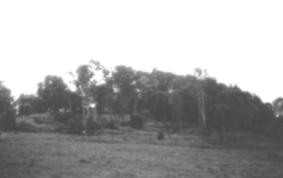
|
The Remains of The Gympie Pyramid
Found by Rex Gilroy
Pyramids have always had a mystical hold on the mind of man. Why is this so? What is it about the pyramids that capture our imagination? They are to found from the desert sands of Egypt to the jungles of New Guinea and Australia, certain west Pacific Islands and Central America.
It puzzles me why worldwide attention seems permanently focussed upon the geometric dimensions of the Great Pyramid of Giza, and those of the old Amerindian civilisations, while those of the Australian-west Pacific region continue to attract little or no attention from conservative archaeology, both here and overseas.
It is because they are an embarrassing enigma, demonstrating that the earth was explored and mapped thousands of years before the age of Magellan or Cook? The most enigmatic of these relics stands outside the town of Gympie, in south-eastern Queensland.The "Gympie Pyramid" was more than just a ceremonial gathering-place and the centrepiece of probably the most important middle-east mining colony ever established in Australia.
It is also possibly, the resting place of an Australian God-King, powerful enough to dispatch countless mineral-seeking expeditions deep into the Australian interior, or fleets of ships into the Pacific, to establish other colonies in far-flung locations around this continent, and on widely scattered islands beyond the horizon. Gympie came to prominence in 1867, when James Nash scooped up nuggets from a dry creek bed, quickly turning the district into Queensland's most famous goldfield.
By 1909 fifty-one companies were mining gold around the area. Following the arrival of the settlers in the Gympie district in the 1840's and 50's, farmers began turning up some remarkable finds; mystery rock inscriptions, ancient tools of copper and bronze pottery of ancient middle-east origin.
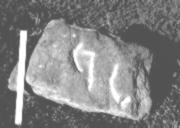
|
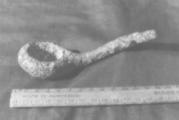
|
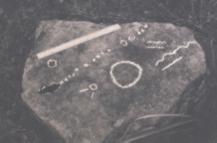
|
|
Inscribed Slab |
Ancient Ladle |
Astronomical Inscription |
Enough too suggest to many inhabitants, that the British colonists were not the first people to settle this district. The region is also rich in copper and tin, as well as jasper, agate and other gemstones. Prospectors exploring the nearby forest-covered mountains and gullies made some startling discoveries in the years following James Nash's gold strike.
Remains of ancient open-cut gold and copper mining operations were uncovered outside Gympie and also the Murgon district further west. Large basalt adzes were found beside quartz reefs where they had been used to pound away at the gold-bearing quartz. At these sites were sometimes found various implements of copper and bronze, later identified as being of ancient middle-east origin.
Somewhere in these jungle covered hills a pre-European water-race built of massive stone blocks was discovered, but the location is now lost. These finds had long since passed into local folklore when, in 1966, farmer Dal.K.Berry {since deceased} ploughing his field one day unearthed the fragmented remains of a crude ironstone idol.
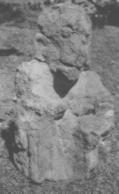
|
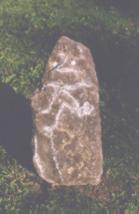
|
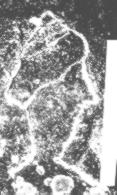
|
|
Gympie Ape Idol |
Second Ape Idol |
Carved Head |
After cementing it together, he found it to be in the form of a 72cm high by 120cm round squatting ape. he also found that he had torn up sandstone blocks which had formed abase upon which the idol had stood. The idol thereafter remained stored away In Dal berry's shed, until oneday in 1975, he read a newspaper article concerning my theories of ancient culture-contacts with Australia. He subsequently wrote to me at our Katoomba, NSW home.
After making the trip to Gympie in October, 1975, Heather and I soon discovered the idol closely resembled middle east examples of the Egyptian god Thoth {inventor of writing} in ape form. Carved between the legs was the papyrus flower symbol, denoting Thoth as the god of writing and knowledge. Thoth was depicted as an ape prior to around 1000 BC, when he became an Ibis-headed, human-bodied entity, who recorded the judgement of the dead in Amenti, the afterworld.
The number of relics, rock inscriptions and traces of extensive ancient gold, copper and tin mining, hereabouts, convinced me that the district had once been the site of an ancient middle-east mining colony.
|
Pyramids
in the Pacific Images Ch
8
|
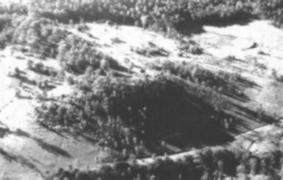
|
Aerial View Of Gympie Pyramid